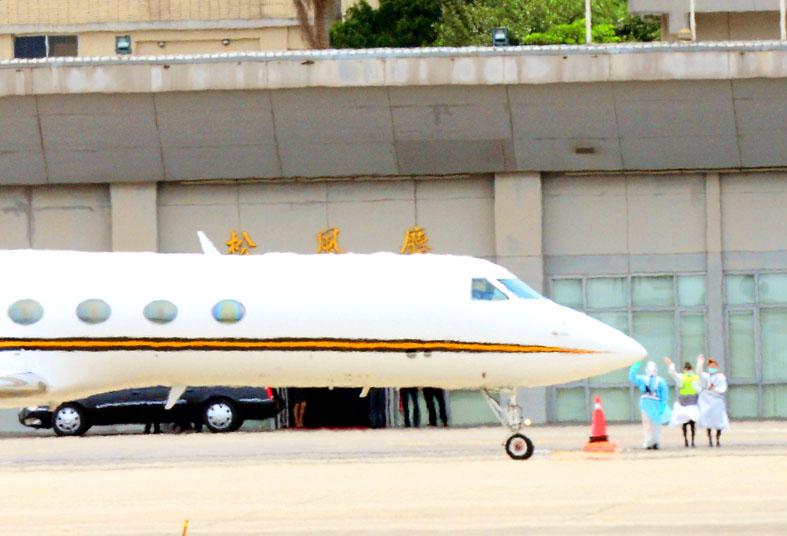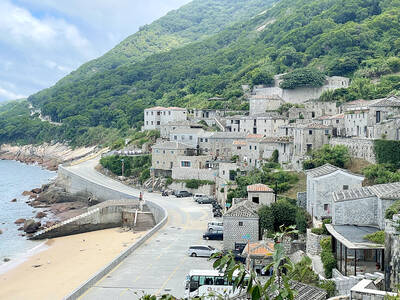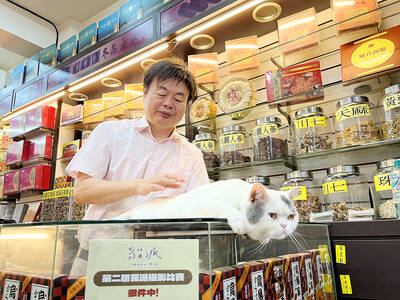A US delegation tasked by US President Joe Biden to reaffirm the country’s commitment to its partnership with Taiwan yesterday wrapped up a three-day visit to Taipei.
Former US senator Chris Dodd, former US deputy secretaries of state Richard Armitage and James Steinberg, and US Department of State Office of Taiwan Coordination Director Dan Biers departed at 11:20am on a private jet.
The members of the delegation, all friends of Biden, arrived on Wednesday and met with President Tsai Ing-wen (蔡英文), Premier Su Tseng-chang (蘇貞昌) and other government officials.

Photo: Wang Yi-sung, Taipei Times
During the three-day visit, the delegation also met with six members of the Legislative Yuan USA Caucus: Democratic Progressive Party legislators Lo Chih-cheng (羅致政) and Wang Ting-yu (王定宇); Chinese Nationalist Party (KMT) legislators Chiang Wan-an (蔣萬安) and Charles Chen (陳以信); Taiwan People’s Party Legislator Ann Kao (高虹安); and independent Legislator Freddy Lim (林昶佐).
During the meeting, members of the delegation asked about the KMT legislators’ interpretation of the so-called “1992 consensus,” sources said.
The “1992 consensus” — a term former Mainland Affairs Council chairman Su Chi (蘇起) admitted making up in 2000 — refers to a tacit understanding between the KMT and the Chinese government that both sides acknowledge there is “one China,” with each side having its own interpretation of what “China” means.
In response to media queries, Chiang yesterday said that he responded by clarifying the “1992 consensus” from three aspects.
First, the “consensus” does not mean “one country, two systems,” a model that the KMT firmly opposes; second, it is a historical fact that has been the basis for cross-strait interaction; and third, there has been discussion within the KMT about whether it should replace the “consensus” with something that could garner more support, Chiang said.
He also told the visitors that Taiwan needs more international space for development and hopefully the US would lend more support for Taiwan to join international organizations, especially the WHO.
Regarding the issue of US pork containing traces of ractopamine, Chiang said they did not discuss the matter with the delegation, saying it is an internal affair.
It is DPP lawmakers who should discuss that issue and ask the delegation what Taiwan would obtain in exchange for lifting restrictions on US pork imports, he said.
KMT Legislator Lin Wei-chou (林為洲), who was also invited to the meeting, said yesterday that he did not attend because the American Institute in Taiwan did not clarify the meeting’s purpose in advance.
As a supporter of an initiative to reinstate a ban on pork products containing ractopamine, he did not want to be pressured by US representatives, Lin said.
Chinese President Xi Jinping (習近平) is to blame for Taiwan’s antipathy toward the “1992 consensus,” because he falsely connected the “consensus” with the concept of exploring a “Taiwan model” under the “one country, two systems” framework, Lin said.
China’s Taiwan Affairs Office spokesman Ma Xiaoguang (馬曉光) has even denied the existence of the Republic of China, meaning he also rejects Taiwan’s interpretation of the “1992 consensus,” Lin said.
Xi, Ma and the DPP have ruined the “consensus,” he added.
Separately, Chen said that in the meeting with the delegation he did not criticize young Taiwanese by saying they lack an understanding of international affairs, as alleged by some DPP lawmakers.
In response to the delegation asking the lawmakers to identify the most critical issues in bilateral relations, a legislator said that the countries should work closer together to tackle unconventional challenges, such as cognitive warfare and influence campaigns, while another legislator called for further cooperation in economic matters and supply chain security, sources said.
Additional reporting by Shih Hsiao-kuang

The Chinese military has built landing bridge ships designed to expand its amphibious options for a potential assault on Taiwan, but their combat effectiveness is limited due to their high vulnerability, a defense expert said in an analysis published on Monday. Shen Ming-shih (沈明室), a research fellow at the Institute for National Defense and Security Research, said that the deployment of such vessels as part of the Chinese People’s Liberation Army (PLA) Navy’s East Sea Fleet signals a strong focus on Taiwan. However, the ships are highly vulnerable to precision strikes, which means they could be destroyed before they achieve their intended

The first two F-16V Bock 70 jets purchased from the US are expected to arrive in Taiwan around Double Ten National Day, which is on Oct. 10, a military source said yesterday. Of the 66 F-16V Block 70 jets purchased from the US, the first completed production in March, the source said, adding that since then three jets have been produced per month. Although there were reports of engine defects, the issue has been resolved, they said. After the jets arrive in Taiwan, they must first pass testing by the air force before they would officially become Taiwan’s property, they said. The air force

GLOBAL: Although Matsu has limited capacity for large numbers of domestic tourists, it would be a great high-end destination for international travelers, an official said Lienchiang County’s (Matsu) unique landscape and Cold War history give it great potential to be marketed as a destination for international travelers, Tourism Administration Director General Chen Yu-hsiu (陳玉秀) said at the weekend. Tourism officials traveled to the outlying island for the Matsu Biennial, an art festival that started on Friday to celebrate Matsu’s culture, history and landscape. Travelers to Matsu, which lies about 190km northwest of Taipei, must fly or take the state-run New Taima passenger ship. However, flights are often canceled during fog season from April to June. Chen spoke about her vision to promote Matsu as a tourist attraction in

PAWSITIVE IMPACT: A shop owner said that while he adopted cats to take care of rodents, they have also attracted younger visitors who also buy his dried goods In Taipei’s Dadaocheng (大稻埕), cats lounging in shops along Dihua Street do more than nap amid the scent of dried seafood. Many have become beloved fixtures who double as photography models, attracting visitors and helping boost sales in one of the capital’s most historic quarters. A recent photo contest featuring more than a dozen shop cats drew more than 2,200 submissions, turning everyday cat-spotting into a friendly competition that attracted amateur and professional photographers. “It’s rare to see cats standing, so when it suddenly did, it felt like a lucky cat,” said Sabrina Hsu (徐淳蔚), who won the NT$10,000 top prize in